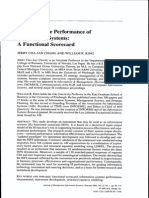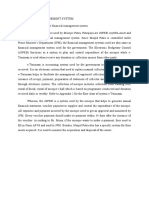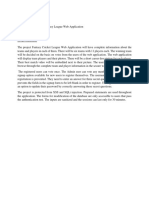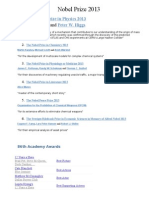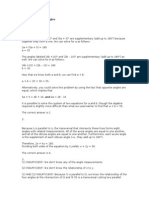Management Information System Chapter 13 GTU MBA
Management Information System Chapter 13 GTU MBA
Uploaded by
Rushabh VoraCopyright:
Available Formats
Management Information System Chapter 13 GTU MBA
Management Information System Chapter 13 GTU MBA
Uploaded by
Rushabh VoraOriginal Title
Copyright
Available Formats
Share this document
Did you find this document useful?
Is this content inappropriate?
Copyright:
Available Formats
Management Information System Chapter 13 GTU MBA
Management Information System Chapter 13 GTU MBA
Uploaded by
Rushabh VoraCopyright:
Available Formats
Chapter 13
Building Information Systems
Management Information Systems
Chapter 13 Building Information Systems LEARNING OBJECTIVES
Demonstrate how building new systems produces organizational change.
Identify and describe the core activities in the systems development process.
Describe the principal methodologies for modeling and designing systems. Compare alternative methodologies for building information systems.
Identify and describe new approaches for system building in the digital firm era.
Management Information Systems
Chapter 13 Building Information Systems PC Connection Makes New System Connections
Problem: Out-of-date, overly manual fulfillment
system; not designed to handle multi-tiered fulfillment system Solutions: Develop in-house new front-end software based on Web services, including business process changes, workflow design, user interface changes Eliminated 90% of manual work for purchase orders; optimizes order fulfillment, links disparate company facilities Illustrates steps needed required to build new systems, from analyzing problems and requirements to managing change
Management Information Systems
Chapter 13 Building Information Systems Systems as Planned Organizational Change
Four kinds of structural organizational change enabled by IT
1. Automation
Increase efficiency, replace manual tasks
2. Rationalization
Streamline standard operating procedures
3. Business process reengineering (BPR)
Analyze, simplify, and redesign business processes
4. Paradigm shifts
Rethink nature of business, define new business model, change nature of organization
Management Information Systems
Chapter 13 Building Information Systems Systems as Planned Organizational Change
Organizational Change Carries Risks and Rewards
The most common forms of organizational change are automation and rationalization. These relatively slow-moving and slow-changing strategies present modest returns but little risk. Faster and more comprehensive changesuch as reengineering and paradigm shiftscarries high rewards but offers substantial chances of failure.
Figure 13-1
Management Information Systems
Chapter 13 Building Information Systems Systems as Planned Organizational Change
Business process reengineering (BPR)
Large payoffs can result from redesigning business processes
Home mortgage industry used IT to redesign mortgage application process BEFORE: 6- to 8-week process costing $3000 AFTER: 1-week process costing $1000 Replaced sequential tasks with work cell or team approach
Work flow management: Process of streamlining business procedures so documents can be moved easily and efficiently
Management Information Systems
Chapter 13 Building Information Systems Systems as Planned Organizational Change
Redesigning Mortgage Processing in the United States
Figure 13-2A
By redesigning their mortgage processing systems and the mortgage application process, mortgage banks have been able to reduce the costs of processing the average mortgage from $3,000 to $1,000 and reduce the time of approval from six weeks to one week or less. Some banks are even preapproving mortgages and locking interest rates on the same day the customer applies.
Management Information Systems
Chapter 13 Building Information Systems Systems as Planned Organizational Change
Redesigning Mortgage Processing in the United States
Figure 13-2B
Management Information Systems
Chapter 13 Building Information Systems Systems as Planned Organizational Change
Steps in effective reengineering
Determine which business processes should be improved
Must avoid becoming good at the wrong process Understand how improving the right processes will help the firm execute its business strategy Understand and measure performance of existing processes as a baseline Even with effective BPR, majority of reengineering projects do not achieve breakthrough gains because of inadequate change management
Management Information Systems
Chapter 13 Building Information Systems Systems as Planned Organizational Change
Business process management (BPM)
Helps firms manage incremental process changes
Uses process-mapping tools to:
Identify and document existing processes
Create models of improved processes that can be translated into software systems
Measure impact of process changes on key business performance indicators
Management Information Systems
Chapter 13 Building Information Systems Systems as Planned Organizational Change
Business process management (cont.) Includes:
Work flow management Business process modeling notation Quality measurement and management Change management Tools for standardizing business processes so they can be continually manipulated Process monitoring and analytics
To verify process performance has improved and measure impact of process changes on key business performance indicators
Management Information Systems
Chapter 13 Building Information Systems Systems as Planned Organizational Change
Quality management:
Fine-tuning business processes to improve quality in their products, services, and operations
The earlier in the business cycle a problem is eliminated, the less it costs the company Quality improvements raise level of product and service quality as well as lower costs
Management Information Systems
Chapter 13 Building Information Systems Systems as Planned Organizational Change
Total Quality Management (TQM):
Achievement of quality control is end in itself Everyone is expected to contribute to improvement of quality Focuses on continuous improvements rather than dramatic bursts of change
Six sigma:
Specific measure of quality 3.4 defects per million opportunities
Uses statistical analysis tools to detect flaws in the execution of an existing process and make minor adjustments
Management Information Systems
Chapter 13 Building Information Systems Systems as Planned Organizational Change
Information systems support quality improvements by helping firms:
Simplify products or processes Make improvements based on customer demands Reduce cycle time Improve quality and precision of design and production Meet benchmarking standards
Benchmarking: Setting strict standards for products, services, and other activities, and then measuring performance against those standards
Management Information Systems
Chapter 13 Building Information Systems Overview of Systems Development
Systems development: Activities that go into producing an information system solution to an organizational problem or opportunity
Systems analysis Systems design Programming Testing Conversion Production and maintenance
Management Information Systems
Chapter 13 Building Information Systems Overview of Systems Development
The Systems Development Process
Building a system can be broken down into six core activities.
Figure 13-3
Management Information Systems
Chapter 13 Building Information Systems Overview of Systems Development
Systems analysis
Analysis of problem that will be solved by system
Defining the problem and identifying causes Specifying solutions Systems proposal report identifies and examines alternative solutions Identifying information requirements
Includes feasibility study
Is solution feasible from financial, technical, organizational standpoint Is solution a good investment? Is required technology, skill available?
Management Information Systems
Chapter 13 Building Information Systems Overview of Systems Development
System analysis (cont.)
Establishing information requirements
Who needs what information, where, when, and how Define objectives of new/modified system Detail the functions new system must perform
Faulty requirements analysis is leading cause of systems failure and high systems development cost
Management Information Systems
Chapter 13 Building Information Systems Overview of Systems Development
Systems design
Describe system specifications that will deliver functions identified during systems analysis Should address all managerial, organizational, and technological components of system solution
Role of end users
User information requirements drive system building Users must have sufficient control over design process to ensure that system reflects their business priorities and information needs Insufficient user involvement in design effort is major cause of system failure
Management Information Systems
Chapter 13 Building Information Systems Overview of Systems Development
Design Specifications
OUTPUT Medium Content Timing INPUT Origins Flow Data entry USER INTERFACE Simplicity Efficiency Logic Feedback Errors DATABASE DESIGN Logical data model Volume and speed requirements File organization and design Record specifications PROCESSING Computations Program modules Required reports Timing of outputs MANUAL PROCEDURES What activities Who performs them When How Where CONTROLS Input controls (characters, limit, reasonableness) Processing controls (consistency, record counts) Output controls (totals, samples of output) Procedural controls (passwords, special forms) DOCUMENTATION Operations documentation Systems documents User documentation CONVERSION Transfer files Initiate new procedures Select testing method Cut over to new system TRAINING Select training techniques Develop training modules Identify training facilities ORGANIZATIONAL CHANGES Task redesign Job redesign Process design Organization structure design Reporting relationships
SECURITY Access controls Catastrophe plans Audit trails
Management Information Systems
Chapter 13 Building Information Systems Alternative Systems-Building Approaches
Dorfman Pacific Rolls Out a New Wireless Warehouse Read the Interactive Session: Organizations, and then discuss the following questions:
Compare Dorfman Pacifics old and new order-picking processes. Diagram the processes. What role did end users play in developing Dorfmans wireless warehouse system? What would have happened to the project if users hadnt been so involved? Explain your answer. What types of system building methods and tools did Dorfman use for building its wireless warehouse system?
How did the new system change the way Dorfman ran its business?
What problems did the new system solve? Was it successful?
Management Information Systems
Chapter 13 Building Information Systems Overview of Systems Development
Programming:
System specifications from design stage are translated into software program code Software may be purchased, leased, or outsourced instead
Testing
To ensure system produces right results Unit testing: Tests each program in system separately System testing: Tests functioning of system as a whole Acceptance testing: Makes sure system is ready to be used in production setting Test plan: All preparations for series of tests
Management Information Systems
Chapter 13 Building Information Systems Overview of Systems Development
A Sample Test Plan to Test a Record Change
When developing a test plan, it is imperative to include the various conditions to be tested, the requirements for each condition tested, and the expected results. Test plans require input from both end users and information systems specialists.
Figure 13-4
Management Information Systems
Chapter 13 Building Information Systems Overview of Systems Development
Conversion
Process of changing from old system to new system
Four main strategies
1. Parallel strategy 2. Direct cutover 3. Pilot study 4. Phased approach Requires end-user training Finalization of detailed documentation showing how system works from technical and end-user standpoint
Management Information Systems
Chapter 13 Building Information Systems Overview of Systems Development
Production and maintenance
System reviewed to determine if any revisions needed May prepare formal postimplementation audit document Maintenance
Changes in hardware, software, documentation, or procedures to a production system to correct errors, meet new requirements, or improve processing efficiency 20% debugging, emergency work 20% changes to hardware, software, data, reporting 60% of work: User enhancements, improving documentation, recoding for greater processing efficiency
Management Information Systems
Chapter 13 Building Information Systems Overview of Systems Development
Summary of Systems Development Activities
CORE ACTIVITY
Systems analysis
DESCRIPTION
Identify problem(s) Specify solutions Establish information requirements Create design specifications
Systems design
Programming
Translate design specifications into code Unit test Systems test Acceptance test Plan conversion Prepare documentation Train users and technical staff Operate the system Evaluate the system Modify the system
Testing
Conversion
Production and maintenance
Management Information Systems
Chapter 13 Building Information Systems Overview of Systems Development
Most prominent methodologies for modeling and designing systems:
Structured methodologies Object-oriented development
Structured methodologies
Structured: Techniques are step-by-step, progressive Process-oriented: Focusing on modeling processes or actions that manipulate data Separate data from processes
Management Information Systems
Chapter 13 Building Information Systems Overview of Systems Development
Data flow diagram:
Primary tool for representing systems component processes and flow of data between them
Offers logical graphic model of information flow High-level and lower-level diagrams can be used to break processes down into successive layers of detail
Data dictionary: Defines contents of data flows and data stores Process specifications: Describe transformation occurring within lowest level of data flow diagrams Structure chart: Top-down chart, showing each level of design, relationship to other levels, and place in overall design structure
Management Information Systems
Chapter 13 Building Information Systems Overview of Systems Development
Data Flow Diagram for Mail-In University Registration System
Figure 13-5
The system has three processes: Verify availability (1.0), Enroll student (2.0), and Confirm registration (3.0). The name and content of each of the data flows appear adjacent to each arrow. There is one external entity in this system: the student. There are two data stores: the student master file and the course file.
Management Information Systems
Chapter 13 Building Information Systems Overview of Systems Development
High-Level Structure Chart for a Payroll System
This structure chart shows the highest or most abstract level of design for a payroll system, providing an overview of the entire system.
Figure 13-6
Management Information Systems
Chapter 13 Building Information Systems Overview of Systems Development
Object-oriented development
Uses object as basic unit of systems analysis and design
Object: Combines data and the specific processes that operate on those data
Data encapsulated in object can be accessed and modified only by operations, or methods, associated with that object
Object-oriented modeling based on concepts of class and inheritance
Objects belong to a certain class and have features of that class
May inherit structures and behaviors of a more general, ancestor class
Management Information Systems
Chapter 13 Building Information Systems Overview of Systems Development
Class and Inheritance
This figure illustrates how classes inherit the common features of their superclass.
Figure 13-7
Management Information Systems
Chapter 13 Building Information Systems Overview of Systems Development
Object-oriented development
More iterative and incremental than traditional structured development
Systems analysis: Interactions between system and users analyzed to identify objects Design phase: Describes how objects will behave and interact; grouped into classes, subclasses and hierarchies Implementation: Some classes may be reused from existing library of classes, others created or inherited
Because objects reusable, object-oriented development can potentially reduce time and cost of development
Management Information Systems
Chapter 13 Building Information Systems Overview of Systems Development
Computer-aided software engineering (CASE)
Software tools to automate development and reduce repetitive work, including
Graphics facilities for producing charts and diagrams Screen and report generators, reporting facilities
Analysis and checking tools
Data dictionaries Code and documentation generators
Support iterative design by automating revisions and changes and providing prototyping facilities Require organizational discipline to be used effectively
Management Information Systems
Chapter 13 Building Information Systems Alternative Systems-Building Approaches
Alternative Systems-Building Methods
Traditional systems life-cycle
Prototyping End-user development
Application software packages
Outsourcing
Management Information Systems
Chapter 13 Building Information Systems Alternative Systems-Building Approaches
Traditional systems lifecycle:
Oldest method for building information systems Phased approach - divides development into formal stages Follows waterfall approach: Tasks in one stage finish before another stage begins
Maintains formal division of labor between end users and information systems specialists
Emphasizes formal specifications and paperwork Still used for building large complex systems Can be costly, time-consuming, and inflexible
Management Information Systems
Chapter 13 Building Information Systems Alternative Systems-Building Approaches
Prototyping
Building experimental system rapidly and inexpensively for end users to evaluate Prototype: Working but preliminary version of information system Approved prototype serves as template for final system 1. Identify user requirements 2. Develop initial prototype 3. Use prototype 4. Revise and enhance prototype Steps in prototyping
Management Information Systems
Chapter 13 Building Information Systems Alternative Systems-Building Approaches
The Prototyping Process
Figure 13-8
The process of developing a prototype can be broken down into four steps. Because a prototype can be developed quickly and inexpensively, systems builders can go through several iterations, repeating steps 3 and 4, to refine and enhance the prototype before arriving at the final operational one.
Management Information Systems
Chapter 13 Building Information Systems Alternative Systems-Building Approaches
Advantages of prototyping Useful if some uncertainty in requirements or design solutions Often used for end-user interface design More likely to fulfill end-user requirements Disadvantages May gloss over essential steps May not accommodate large quantities of data or large number of users May not undergo full testing or documentation
Management Information Systems
Chapter 13 Building Information Systems Alternative Systems-Building Approaches
End-user development:
Uses fourth-generation languages to allow end-users to develop systems with little or no help from technical specialists Fourth generation languages: Less procedural than conventional
programming languages PC software tools
Query languages Report generators Graphics languages Application generators Application software packages Very high-level programming languages
Management Information Systems
Chapter 13 Building Information Systems Alternative Systems-Building Approaches
End-user development (cont.):
Advantages:
More rapid completion of projects High-level of user involvement and satisfaction
Disadvantages:
Not designed for processing-intensive applications
Inadequate management and control, testing, documentation Loss of control over data
Managing end-user development
Require cost-justification of end-user system projects
Establish hardware, software, and quality standards
Management Information Systems
Chapter 13 Building Information Systems Alternative Systems-Building Approaches
Application software packages
Save time and money Many packages offer customization features:
Allow software package to be modified to meet unique requirements without destroying integrity of package software
Evaluation criteria for systems analysis include:
Functions provided by the package, flexibility, user friendliness, hardware and software resources, database requirements, installation and maintenance efforts, documentation, vendor quality, and cost
Request for Proposal (RFP)
Detailed list of questions submitted to packaged-software vendors Used to evaluate alternative software packages
Management Information Systems
Chapter 13 Building Information Systems Alternative Systems-Building Approaches
Outsourcing
Several types
Cloud and SaaS providers
Subscribing companies use software and computer hardware provided by vendors
External vendors
Hired to design, create software Domestic outsourcing Driven by firms need for additional skills, resources, assets Offshore outsourcing Driven by cost-savings
Management Information Systems
Chapter 13 Building Information Systems Alternative Systems-Building Approaches
Outsourcing (cont.)
Advantages Allows organization flexibility in IT needs Disadvantages Hidden costs, e.g. Identifying and selecting vendor Transitioning to vendor Opening up proprietary business processes to third party
Management Information Systems
Chapter 13 Building Information Systems Overview of Systems Development
Total Cost of Offshore Outsourcing
If a firm spends $10 million on offshore outsourcing contracts, that company will actually spend 15.2 percent in extra costs even under the best-case scenario. In the worst-case scenario, where there is a dramatic drop in productivity along with exceptionally high transition and layoff costs, a firm can expect to pay up to 57 percent in extra costs on top of the $10 million outlay for an offshore contract.
Figure 13-9
Management Information Systems
Chapter 13 Building Information Systems Systems as Planned Organizational Change
Did Chrysler Make the Right Outsourcing Decision? Read the Interactive Session: Management, and then discuss the following questions:
What management, organization, and technology issues should Chrysler have explored when deciding whether to outsource to TCS?
What points should Chrysler have addressed in its outsourcing contract with TCS?
Was Tata Consultancy Services a good outsourcing choice for Chrysler? Why or why not? Explain your answer.
Management Information Systems
Chapter 13 Building Information Systems Application Development for the Digital Firm
Rapid application development (RAD)
Process of creating workable systems in a very short period of time
Utilizes techniques such as:
Visual programming and other tools for building graphical user interfaces Iterative prototyping of key system elements Automation of program code generation
Close teamwork among end users and information systems specialists
Management Information Systems
Chapter 13 Building Information Systems Application Development for the Digital Firm
Joint application design (JAD)
Used to accelerate generation of information requirements and to develop initial systems design Brings end users and information systems specialists together in interactive session to discuss systems design Can significantly speed up design phase and involve users at intense level
Management Information Systems
Chapter 13 Building Information Systems Application Development for the Digital Firm
Agile development
Focuses on rapid delivery of working software by breaking large project into several small subprojects Subprojects
Treated as separate, complete projects Completed in short periods of time using iteration and continuous feedback
Emphasizes face-to-face communication over written documents, allowing collaboration and faster decision making
Management Information Systems
Chapter 13 Building Information Systems Application Development for the Digital Firm
Component-based development
Groups of objects that provide software for common functions (e.g., online ordering) and can be combined to create large-scale business applications Web services
Reusable software components that use XML and open Internet standards (platform independent) Enable applications to communicate with no custom programming required to share data and services Can engage other Web services for more complex transactions Using platform and device-independent standards can result in significant cost-savings and opportunities for collaboration with other companies
You might also like
- QA Ken Black All Chapters SolutionDocument1,244 pagesQA Ken Black All Chapters SolutionRushabh Vora88% (129)
- Flukuto ExamsDocument5 pagesFlukuto ExamseeeemacarneaNo ratings yet
- Advanced Database Management SystemsDocument1 pageAdvanced Database Management Systemssakeynii100% (1)
- IM Ch05 Advanced Data Modeling Ed9Document20 pagesIM Ch05 Advanced Data Modeling Ed9msalmohaya33% (12)
- A Business Case For Online Shopping CentreDocument3 pagesA Business Case For Online Shopping CentreSiddharth Yadav TYIT54No ratings yet
- 8 Major Impacts of Information Technology On BusinessesDocument6 pages8 Major Impacts of Information Technology On BusinessesGetnet MuhabawNo ratings yet
- ERP Solutions: Software Requirements SpecificationDocument33 pagesERP Solutions: Software Requirements SpecificationAr JunNo ratings yet
- Building Information SystemsDocument25 pagesBuilding Information SystemsCamilo AmarcyNo ratings yet
- Building Information Systems: Managing The Digital Firm, 12 EditionDocument25 pagesBuilding Information Systems: Managing The Digital Firm, 12 Editionmahamud100% (1)
- Interactive Session:Technology: What Does It Take To Go Mobile?Document9 pagesInteractive Session:Technology: What Does It Take To Go Mobile?Daniela MedranoNo ratings yet
- MIS Question BankDocument4 pagesMIS Question BankShivam guptaNo ratings yet
- System Analysis and Design ProjectDocument5 pagesSystem Analysis and Design ProjectOkoro Monney100% (1)
- Use CasesDocument6 pagesUse CasesNancy PaulNo ratings yet
- 1.1. Marketing ResearchDocument22 pages1.1. Marketing ResearchAnamika Rai PandeyNo ratings yet
- IT Infrastructure & EmergingDocument2 pagesIT Infrastructure & Emergingpmech consultantNo ratings yet
- Association Rule Generation For Student Performance Analysis Using Apriori AlgorithmDocument5 pagesAssociation Rule Generation For Student Performance Analysis Using Apriori AlgorithmthesijNo ratings yet
- Mis Foundation of Information Systems in BusinessDocument50 pagesMis Foundation of Information Systems in BusinessArslan KhaliqNo ratings yet
- Management Information System LIC - To Be PrintedDocument6 pagesManagement Information System LIC - To Be PrintedYeabkal BelegeNo ratings yet
- Chap 9 QuizDocument4 pagesChap 9 QuizPaaforiNo ratings yet
- Management Information System (Mis) : 1. Technical ApproachDocument4 pagesManagement Information System (Mis) : 1. Technical ApproachPrashanth BnNo ratings yet
- Capstone Project Report: Online Rental SystemDocument9 pagesCapstone Project Report: Online Rental SystemKajalNo ratings yet
- Student Information System-3279Document7 pagesStudent Information System-3279Giveheart LambasNo ratings yet
- Automated Payment SystemDocument12 pagesAutomated Payment SystemJillian HartNo ratings yet
- MIS Chapter 1 - Information SystemsDocument4 pagesMIS Chapter 1 - Information Systemsstephenwainaina994No ratings yet
- Lecture 4 (Enterprise Systems)Document31 pagesLecture 4 (Enterprise Systems)Jia AhmedNo ratings yet
- CRMDocument63 pagesCRMPrateek KhannaNo ratings yet
- Case Study On: Piloting Procter & Gamble From Decision CockpitsDocument3 pagesCase Study On: Piloting Procter & Gamble From Decision CockpitsSabbir AhmedNo ratings yet
- E Commerce AssignmentDocument5 pagesE Commerce Assignmentkamilbisma100% (1)
- IT Infrastructure and Emerging TechnologiesDocument20 pagesIT Infrastructure and Emerging Technologiesemfallon100% (1)
- Review Related Literature Record Management SystemDocument6 pagesReview Related Literature Record Management SystemaflstfcapNo ratings yet
- Measuring The Performance of Information Systems: A Functional ScorecardDocument32 pagesMeasuring The Performance of Information Systems: A Functional ScorecardAriful Islam ApuNo ratings yet
- Conceptual Model of The StudyDocument2 pagesConceptual Model of The StudyRj ANo ratings yet
- 6ed Solutions Chap03Document22 pages6ed Solutions Chap03JesseSpero50% (2)
- IT Infrastructure & Emerging TechnologiesDocument6 pagesIT Infrastructure & Emerging TechnologiesAnyun SharmaNo ratings yet
- ADAIS-SWOT AnalysisDocument3 pagesADAIS-SWOT AnalysisNor FarahNo ratings yet
- Assignment No-5: Q. What Are The Evaluation Criteria of Benefits of Innovation For BussinessDocument9 pagesAssignment No-5: Q. What Are The Evaluation Criteria of Benefits of Innovation For BussinessPROFESSIONAL SOUNDNo ratings yet
- Design and Implementation of E-Commerce Site For Online ShoppingDocument22 pagesDesign and Implementation of E-Commerce Site For Online ShoppingMansab AliNo ratings yet
- Employability & Professional DevelopmentDocument18 pagesEmployability & Professional DevelopmentGolam Kibria BhuiyanNo ratings yet
- The Role of Marketing Capabilities For The Competitive Advantage in The Slovenian MarketDocument15 pagesThe Role of Marketing Capabilities For The Competitive Advantage in The Slovenian Marketxaxif8265No ratings yet
- Literature Review On Online Reverse Auctions ResearchDocument20 pagesLiterature Review On Online Reverse Auctions ResearchMegat Shariffudin Zulkifli, DrNo ratings yet
- System Analysis and Design Assignment 4Document4 pagesSystem Analysis and Design Assignment 4Hummi KhanNo ratings yet
- Module 3 and 4 - ERP ImplementationDocument21 pagesModule 3 and 4 - ERP ImplementationABHIJITH DASNo ratings yet
- Executive Summary IWMS Business CaseDocument1 pageExecutive Summary IWMS Business CaseRadit AdiNo ratings yet
- Business Analytics NotesDocument4 pagesBusiness Analytics NotesShubham TitoriaNo ratings yet
- Benta - A Scalable Web-Based Point of Sale System Built On Laravel FrameworkDocument5 pagesBenta - A Scalable Web-Based Point of Sale System Built On Laravel FrameworkInternational Journal of Innovative Science and Research TechnologyNo ratings yet
- Chapter Five Value of I.TDocument5 pagesChapter Five Value of I.TRizza L. MacarandanNo ratings yet
- Software Development Model QuestionnaireDocument8 pagesSoftware Development Model QuestionnaireSivasakti MarimuthuNo ratings yet
- Business Plan UniKL Template - MPU3232 Sep2014Document10 pagesBusiness Plan UniKL Template - MPU3232 Sep2014Adalberto FrancisNo ratings yet
- Importance of Labor RelationDocument5 pagesImportance of Labor RelationBeah RoblesNo ratings yet
- Cost Benefit AnalysisDocument3 pagesCost Benefit AnalysisSangita PoudelNo ratings yet
- Supply Chain Management Information SystemsDocument16 pagesSupply Chain Management Information SystemsKimchee StudyNo ratings yet
- Assignment On E-CommerceDocument12 pagesAssignment On E-CommerceMd Kowsar HamidNo ratings yet
- Assignment Software Design and DevelopmentDocument28 pagesAssignment Software Design and DevelopmentShamir ShahriarNo ratings yet
- E CommerceDocument78 pagesE CommerceAhmed Fayek100% (1)
- CRM and Database MarketingDocument25 pagesCRM and Database MarketingFortunateNo ratings yet
- Automation of Training and Placement Operations-AbstractDocument2 pagesAutomation of Training and Placement Operations-AbstractRamya RachurNo ratings yet
- COBIT FrameworkDocument9 pagesCOBIT FrameworkHidayat KampaiNo ratings yet
- ScopeStatement HariniIyerDocument1 pageScopeStatement HariniIyerHarini IyerNo ratings yet
- Corporate HRM Information Scheduler: Submitted in Partial Fulfillment of The Requirement For The Award of Degree ofDocument50 pagesCorporate HRM Information Scheduler: Submitted in Partial Fulfillment of The Requirement For The Award of Degree ofAnonymous ty7mAZNo ratings yet
- Qualitative ResearchDocument18 pagesQualitative ResearchLily HânNo ratings yet
- System Request - Enrollment System Project Project Sponsor: Business NeedDocument3 pagesSystem Request - Enrollment System Project Project Sponsor: Business NeedHiraya ManawariNo ratings yet
- Critical Thinking Assignment 1Document3 pagesCritical Thinking Assignment 1Rushabh VoraNo ratings yet
- GK 2014Document45 pagesGK 2014Rushabh VoraNo ratings yet
- GMAT Quant Topic 5 - Geometry SolutionsDocument51 pagesGMAT Quant Topic 5 - Geometry SolutionsRajthilak_omNo ratings yet
- GMAT Quant Topic 6 Co-Ordinate Geometry SolutionsDocument20 pagesGMAT Quant Topic 6 Co-Ordinate Geometry SolutionsRushabh VoraNo ratings yet
- Eaton Worldwide: Type: - PublicDocument34 pagesEaton Worldwide: Type: - PublicRushabh VoraNo ratings yet
- On Environmental Factors Responsible For Idbi's PerformanceDocument53 pagesOn Environmental Factors Responsible For Idbi's PerformanceRushabh VoraNo ratings yet
- MBA SIP Project On BSNLDocument16 pagesMBA SIP Project On BSNLRushabh VoraNo ratings yet
- A Multidimensional Platform Ecosystem FrameworkDocument33 pagesA Multidimensional Platform Ecosystem FrameworkCao TuấnNo ratings yet
- S7 Programming 3 Course (ST-PRO3) : Short DescriptionDocument1 pageS7 Programming 3 Course (ST-PRO3) : Short DescriptionminahannaNo ratings yet
- FactoryTalk Historian Vision Customer Presentation-1Document23 pagesFactoryTalk Historian Vision Customer Presentation-1melbisferNo ratings yet
- Manabat, Yla Chaemil S. AE-302 TECHENTREPDocument3 pagesManabat, Yla Chaemil S. AE-302 TECHENTREPyla manabatNo ratings yet
- Tendernotice 1Document5 pagesTendernotice 1JRB BelgaumNo ratings yet
- OPCF Ebook v4 2021Document30 pagesOPCF Ebook v4 2021Sérgio SantosNo ratings yet
- ACC223 ModuleDocument73 pagesACC223 Module22-52403No ratings yet
- NEW Article FOR Someone: Page StructureDocument3 pagesNEW Article FOR Someone: Page StructureClang ServerNo ratings yet
- Mba Syllabus 4TH SemesterDocument99 pagesMba Syllabus 4TH SemesterRaahmiNo ratings yet
- GraphicDesign Calendar Carmelita ZabalaDocument28 pagesGraphicDesign Calendar Carmelita Zabalacarmelita zabalaNo ratings yet
- EN WBNR SlideDeck SREVM24013Document141 pagesEN WBNR SlideDeck SREVM24013AdolfoGarciaNo ratings yet
- PS4S16 Managing Projects & Programmes CW1 Fabia-1Document20 pagesPS4S16 Managing Projects & Programmes CW1 Fabia-1Dhruba deyNo ratings yet
- EcoDomus Presentation LuatNKTDocument40 pagesEcoDomus Presentation LuatNKTViet-Dzung HoangNo ratings yet
- RBI vs. TBIDocument1 pageRBI vs. TBIJoshi DhvanitNo ratings yet
- 1qg S4hana2021 BPD en MXDocument21 pages1qg S4hana2021 BPD en MXEnrique MarquezNo ratings yet
- IBM Power Solutions: Kim Querner Director of Power Solutions & Ecosystem Gina King Power Solutions ManagerDocument23 pagesIBM Power Solutions: Kim Querner Director of Power Solutions & Ecosystem Gina King Power Solutions ManagerokbaNo ratings yet
- Resume - Jacob BandenburgDocument1 pageResume - Jacob Bandenburgapi-545268426No ratings yet
- Anatomy of A Software House 1Document11 pagesAnatomy of A Software House 1fareedullahhamdard7No ratings yet
- Big Picture D Week 8-9Document8 pagesBig Picture D Week 8-9leovanne andre romaNo ratings yet
- FYP Comments (11 Oct, 24)Document8 pagesFYP Comments (11 Oct, 24)allahdittahammadNo ratings yet
- OpTransactionHistoryUX525 04 2024Document14 pagesOpTransactionHistoryUX525 04 2024klmbrthrsNo ratings yet
- Transonic Technical Terms Form FillingDocument2 pagesTransonic Technical Terms Form FillingSylaj100% (1)
- C1000-066 Exam: IBM Cloud Pak For Data Solution Architect V2.5 ExamDocument4 pagesC1000-066 Exam: IBM Cloud Pak For Data Solution Architect V2.5 ExamMahendran BaluNo ratings yet
- Module 2: Manage User Rights and Profiles Module Overview: ObjectivesDocument32 pagesModule 2: Manage User Rights and Profiles Module Overview: ObjectivesYudiana MarreroNo ratings yet
- How Would The Wireless Telecom Industry Be Impacted by Google's Entry in The Same, Armed With Android?Document1 pageHow Would The Wireless Telecom Industry Be Impacted by Google's Entry in The Same, Armed With Android?DIVISHA GUPTANo ratings yet
- Hadi Khaleghi - Software Test Lead: Hadi@khaleghi - Co.uk WWW - Khaleghi.co - UkDocument2 pagesHadi Khaleghi - Software Test Lead: Hadi@khaleghi - Co.uk WWW - Khaleghi.co - UkRicha TanwarNo ratings yet
- IDfy Case Studies PDFDocument8 pagesIDfy Case Studies PDFAvishekNNo ratings yet
- Digital Transformation in Local Governments: A Comparative StudyDocument9 pagesDigital Transformation in Local Governments: A Comparative StudyYusef MohamedNo ratings yet
- Multi-Vendor Ecommerce Website: Ms. Kamakshi Gupta, Muskan Goel, Sumit Kumar, Nikhil RawatDocument6 pagesMulti-Vendor Ecommerce Website: Ms. Kamakshi Gupta, Muskan Goel, Sumit Kumar, Nikhil RawatAbdiraxman MaxamedNo ratings yet































